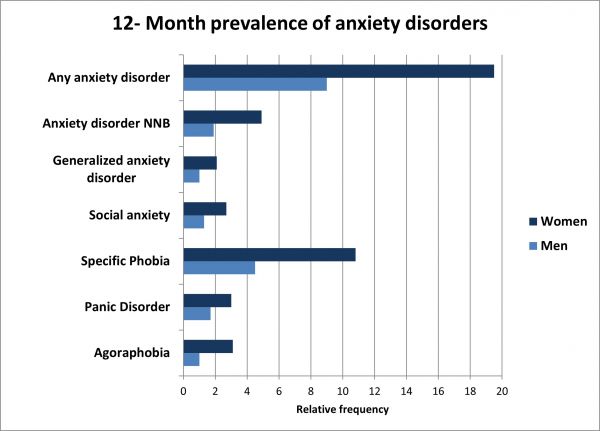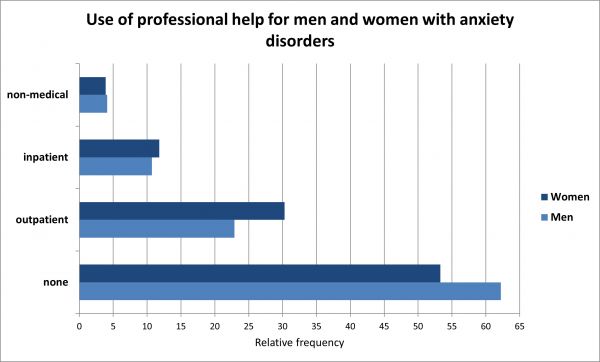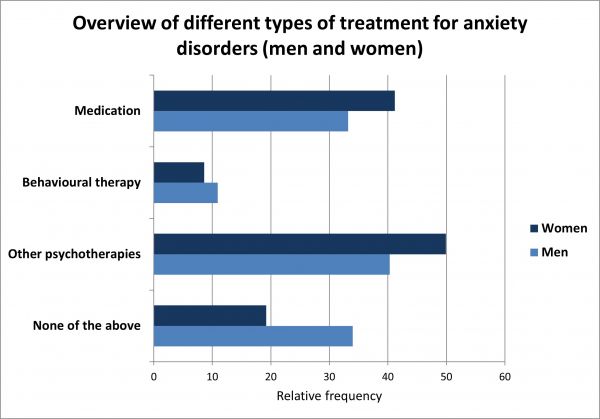Anxiety Disorders/Expert
Contents
Epidemiology
The study ''Health of Adults in Germany'' (DEGS1-MH, 2014) shows that 15.3 percent of German residents (between 18 and 79 years old) suffered from a clinically relevant anxiety disorder within a period of one year. This affects 21.3 percent of women and 9.3 percent of men. Women are therefore at least twice as likely to develop an anxiety disorder as men (see Figure 1). [1] [2]
Figure 1: Prevalence of anxiety disorders in men and women diagnosed according to DSM-IV [Source: GenderMed-Wiki, according to Wittchen & Jacobi (2007). From: BGS 1998
Findings from a Dutch health report (1998) indicate a relatively small difference between 12-month and lifetime prevalence, thus illustrating the often chronic course of anxiety disorders. [3] The following table (Table 1) provides an overview of lifetime prevalence and sex distribution of different anxiety disorders. [4]
Table 1: Lifetime prevalence and sex ratio. [Source: Voderholzer & Hohagen (2013)]
| Disorder | Panic disorder/Agoraphobia | Generalized anxiety disorder | Social phobia | Specific phobia |
| Lifetime prevalence | 6.1% | 5.7% | 12.1% | 12.5% |
|
Sex ratio (Women:Men) |
2.2:1 | 2:1 | 1.4:1 | 2.3:1 |
Anxiety disorders generally arise in the second to fourth decade. However, 60 percent of all anxiety disorders first manifest before the age of 21 (subject to retrospective bias). The average onset of disease, which represents the earliest initial manifestation of the specific phobias, is 16 years (14.9 years for women, 19.4 years for men). Generalized anxiety disorder has the highest average age of onset with 35 years (33.6 years for women, 39.3 years for men). Sex differences in the initial manifestation of the respective anxiety disorders are shown in Figure 2. It is noteworthy that the prevalence rates for both sexes are the same over different age groups, resulting in a constant sex ratio (odds ratio between 2.5 and 2.8, see Table 2). Age therefore does not appear to have any influence on the development of an anxiety disorder, and the sex difference in prevalence remains constant across all age groups. [5]
Table 2: One-month prevalence of anxiety disorders in Germany. [Source: Wittchen et al. 1999]
| Age | Women | Men | Ratio (w:m) |
| 18-35 | 13.3% | 5.5% | 2.66 |
| 36-45 | 12.6% | 4.9% | 2.79 |
| 46-65 | 12.3% | 5.3% | 2.52 |
| Total | 12.7% | 5.3% | 2.64 |
Figure 2: Average age of first manifestation of an anxiety disorder in men and women [Source: GenderMed-Wiki, after Wittchen & Jacobi (2007). from: BGS 1998].
Incidence/Prevalence
Risk and protective factors
Pathophysiology
Clinical presentation
Symptoms
Diagnostics
Patient management
Therapy
According to data from the German Health Survey of 1998, only about 38 percent of men and 46 percent of women with an anxiety disorder visit a medical or non-medical care facility (regardless of the duration, type or frequency of treatment). Despite the availability of effective treatment options, less than half of those with anxiety disorders seek professional help (44 percent in total). Figure 3 shows the use of healthcare facilities among women and men with anxiety disorders. [2]
There are also sex differences in the type of outpatient treatment, with women accepting all types of treatment more often than men (see Figure 4). The different use of therapy services depends on sex and gender and can be explained, among other things, by different patterns of seeking help: affected women are more likely to seek out medical support and undergo treatment more often than men. [6] In addition, women in the medical setting report emotional complaints much more frequently, which in itself results in a higher number of diagnoses and treatments for anxiety disorders. Even if these emotional complaints have no disease potential, women make use of health care services (visits to the doctor) significantly more often than men (19 percent of women and 10 percent of men). In this context the greater health awareness in females and a tendency towards a lesser assessment of psychological influences on health in males most likely contributes to this as well. It is currently not possible to conclusively determine whether different levels of stress or impairment also determine those observed differences in seeking help. Generally speaking, the most common treatment for anxiety patients is psychotherapy. Exclusive pharmacological management was only recorded in 33 percent of men and 41 percent of women. [7]
Figure 3: Use of professional help for men and women with anxiety disorders [Source: GenderMed-Wiki, after Wittchen & Jacobi (2007). from: BGS 1998].
Figure 4: Overview of different types of treatment for anxiety disorders (men and women) [Source: GenderMed-Wiki, after Wittchen & Jacobi (2007). from: BGS 1998]
Physician-patient interaction
Treatment outcome
The following overview provides information on various treatment options and any sex differences in the effectiveness of a treatment. [7]
Table 2: Sex differences in the effectiveness of different treatment methods. [Source: Arolt & Rohde (2007)]
| Disorder | Therapy options | Efficacy in women | Efficacy in men |
| Anxiety disorder and Agoraphobia |
|
Estrogens modulate serotonergic functions and can thus influence the effect of serotonergic drugs. The benzodiazepine receptors are modulated by sex hormones. Sex differences in cognitive behavioural therapy are not known to date. |
|
| Social phobia |
|
Women may benefit more from social skills training. Estrogens modulate serotonergic functions and can thus influence the effect of serotonergic drugs. The benzodiazepine receptors are modulated by sex hormones. |
Men may benefit from cognitive behavioural therapy. |
| Specific phobia |
|
Women may show better efficacy in exposure therapies. |
Men may respond more positively to cognitive behavioural therapy. |
| Generalized Anxiety Disorder |
|
Estrogens modulate serotonergic functions and can thus influence the effect of serotonergic drugs. The benzodiazepine receptors are modulated by sex hormones. |
Psychosocial factors
Women are more likely than men to judge their quality of life and functionality on the basis of psychological problems as well as partnership and occupational status. [8] Nevertheless, it is particularly in men that unemployment and lack of a partner are stronger vulnerability factors for the development of an anxiety disorder. [9] Women report anxiety as a result of adverse life events (especially experiences of loss or danger) more often than men. [7] The sex difference in the prevalence of anxiety disorders is particularly evident in urban compared to rural areas. [10] The prevalence of anxiety disorders is higher in urban communities compared to rural areas.
Prevention
Translation into patient care
Open research questions
Studies that investigate effective sex/gender-sensitive therapies and focus more closely on the female hormone status (cycle phases, contraception, substitution treatment, menopause, etc.) seem particularly necessary. The influence of the sex hormones on pharmacokinetics seems to be relevant for the effectiveness of drug therapies and thus also for the prognosis of disorders. In this context, further analyses of the pathogenesis and treatment of anxiety disorders during pregnancy or postpartum as well as during lactation are urgently recommended. [7]
Outlook
External Links
Literature
- Jacobi F, Höfler M, Strehle J, Mack S, Gerschler A, Scholl L et al. Psychische Störungen in der Allgemeinbevölkerung: Studie zur Gesundheit Erwachsener in Deutschland und ihr Zusatzmodul Psychische Gesundheit (DEGS1-MH). Der Nervenarzt 2014; 85(1):77–87.
- Wittchen H, Jacobi F. Angststörungen. Nachdr. Berlin: Robert Koch-Inst; 2007. (Gesundheitsberichterstattung des Bundes; vol 21).
- Bijl RV, Ravelli A, van Zessen G. Prevalence of psychiatric disorder in the general population: Results of the Netherlands Mental Health Survey and Incidence Study (NEMESIS). Social Psychiatry and Psychiatric Epidemiology 1998; 33(12):587–95.
- Voderholzer U, Hohagen F. Therapie psychischer Erkrankungen: Elsevier Health Sciences Germany; 2013. Available from: URL: https://books.google.de/books?id=_BBACwAAQBAJ.
- Wittchen, H.-U., Müller, N., Pfister, H., Winter, S., & Schmidtkunz, B. (1999). Affektive, somatoforme und Angststörungen in Deutschland. Erste Ergebnisse des bundesweiten Zusatzsurveys "Psychische Störungen". Das Gesundheitswesen, 61, 216-222.
- Dickstein LJ. Gender Differences in Mood and Anxiety Disorders. American Psychiatric Press Review of Psychiatry 2000; 18.
- Arolt V, Rohde A. Geschlechtsspezifische Psychiatrie und Psychotherapie: ein Handbuch: Kohlhammer; 2007. Available from: URL: https://books.google.de/books?id=Nuz_6Ln-UHMC.
- Gamma A, Angst J. Concurrent psychiatric comorbidity and multimorbidity in a community study: Gender differences and quality of life. Eur Arch Psychiatry Clin Nuerosci 2001; 251(S2):43–6.
- Klose M, Jacobi F. Can gender differences in the prevalence of mental disorders be explained by sociodemographic factors? Archives of Women's Mental Health 2004; 7(2):133–48.
- Diala CC. Mood and Anxiety Disorders Among Rural, Urban, and Metropolitan Residents in the United States. Community Mental Health Journal 2003; 39(3):239–52.
License
This article is published under the Creative Commons License. The full license content can be retrieved here: https://creativecommons.org/licenses/by/3.0/legalcode
Autoren
Paulina Juszczyk
Last changed: 2021-10-23 12:20:59




